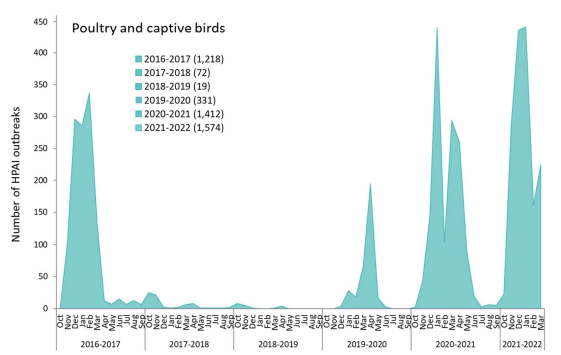While the dominant H5N1 subtype (clade 2.3.4.4b) - which has killed tens of millions of birds across Europe and the United States this past winter - is only known to have mildly infected 2 humans (see here and here), it continues to evolve and has shown an increased affinity for infecting mammalian wildlife in recent years (see here, here, here and here).
As a result, last month the CDC Added Zoonotic Avian A/H5N1 Clade 2.3.4.4b To IRAT List of influenza viruses with at least some pandemic potential. This move came roughly a year after the CDC added HPAI H5N8 (clade 2.3.4.4b) to that list. The CDC currently ranks HPAI H5N1's threat level in the lower-middle of the pack, well below China's EA H1N1 swine-variant virus, or the far more virulent HPAI H5N6, or H7N9 viruses.
While its zoonotic threat could grow over time, for now HPAI H5N1 is primarily a concern for the poultry industry, and a serious threat to wild bird populations.
Although this is the first North American avian epizootic in 7 years, Europe has seen repeated large outbreaks in poultry, and wild birds, since 2017 (see below) as the virus has evolved to adapt to long-term carriage by some species of waterfowl.
UK’s top scientists join forces to battle bird flu outbreaks
Eight of the UK’s top scientific organisations coming together to find new ways to contain bird flu outbreaks.
From:Department for Environment, Food & Rural Affairs, Animal and Plant Health Agency, and UK Research and Innovation Published 20 June 2022
Some of the UK’s top scientists are to set to join forces in a major new research consortium in the UK’s battle against bird flu, it has been announced today (Monday 20 June).
The eight-strong consortium, headed by the world-leading research team at the Animal and Plant Health Agency (APHA), has received £1.5 million from the Biotechnology and Biosciences Research Council (BBSRC) and the Department for Environment, Food and Rural Affairs (Defra) and has been tasked with developing new strategies to tackle future bird flu outbreaks.
This year’s bird flu outbreak has been the largest and longest ever experienced in the UK and in many parts of Europe. The outbreak started earlier than previous years after the virus continued to circulate in Europe over summer 2021 and led to over 100 cases in the UK.
It is hoped the consortium will be able to find new ways to contain future outbreaks. The news will be a significant boost to the UK’s poultry sector and rural economy, which has experienced significant disruption from this year’s outbreak with compulsory indoor housing measures put in place to protect poultry from this horrible disease.
The consortium will focus on building our understanding in a number of key areas, including:
UK’s Chief Veterinary Officer Christine Middlemiss said:
- what it is about the current virus strains that helps them to form larger and longer outbreaks
- understanding transmission and infection in different bird populations, including how the virus transmits from wild birds to farmed poultry, the gaps in biosecurity that allow the virus to penetrate premises, and how this could be addressed
- mapping and modelling the spread of infection over time and across species
- why some birds, such as ducks, are more resistant to bird flu strains
- developing models to predict how the viruses will evolve and spread in the future; and
- inform risk mitigation measures in birds to reduce disease burden thereby protecting against zoonotic transmission occurring from animals to humans, to prevent future spillovers of influenza with pandemic potential into humans.
This new consortium will allow us to combine our expertise at a national level to increase the speed and quality of our research, ensuring we can develop new strategies to aid our efforts against this insidious disease and hopefully in time reduce the impact on the poultry sector.
Professor Ian Brown, APHA’s Head of Virology and project manager, said:
This investment in a new research consortium will bring together the greatest minds from eight world-leading British institutions to address gaps in our understanding of bird flu, helping us to control the spread of the disease, while furthering UK animal health science and ensuring we maintain our world-leading reputation in the field.
Professor Melanie Welham, Executive Chair of BBSRC, said:
One of the real strengths of the UK’s scientific response to disease outbreaks is the way that we can draw on leading researchers from all over the country, who can pool their expertise to deliver results, fast. This new national consortium will study the unprecedented avian influenza outbreak to better understand this latest strain and how to tackle it. This will feed rapidly into government decision-making and new strategies to protect the poultry industry and reduce the risk of future transmission to humans.
UK researchers are already world-leaders in studying bird flu, with the APHA hosting an International Reference Laboratory, which conducts testing on global samples and rapidly shares the latest information internationally on outbreaks. The knowledge gathered will also be shared with international partners to aid their efforts to tackle the disease with benefits for global risk mitigation.
Members of the consortium will also attend a global session this month, hosted by the US Department of Agriculture, where they will influence and coordinate future investment into animal influenza on an international basis.
The $64 question is what happens there?


